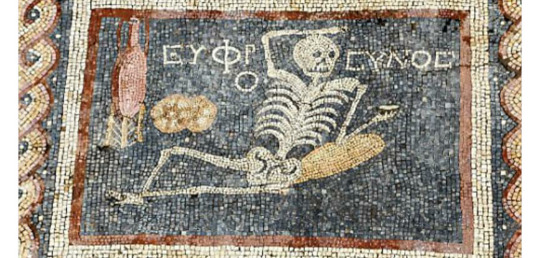I am a professional internet enthusiast. I made Everybody at Once with Slavin and Molly. I also made Know Your Meme with Jamie, Ellie, and Drew. Before that I did a bunch of things in online video and art and activism and internet culture.
Don't wanna be here? Send us removal request.
Text

I get the best recommended content for having the username @kenyatta (this is not a problem btw. This is highly entertaining and should not end.)
#also I used to run blogs for the BBC before the great tumblr porn purge#tracking tags was hilarious
4 notes
·
View notes
Text
“Ever since Kant succeeded in convincing the learned that the world of phenomena is quite other than the world of true reality, and that even our own existence is not our real existence, but only the visible manifestation of a mysterious, unknown substance (substantia) — philosophy has been stuck in a new rut, and cannot move a single millimetre out of the track laid out by the great Königsbergian. Backward or forward it can go, but necessarily in the Kantian rut. For how can you get out of the counterposing of the phenomenon against the thing-in-itself?”
— Lev Shestov, All Things Are Possible
58 notes
·
View notes
Text
24K notes
·
View notes
Text


this is, as the kids say, frying me (a glasses wearer)
136K notes
·
View notes
Text

Airship flying over the Montmartre, Paris
French vintage postcard
376 notes
·
View notes
Text
the best part of that david lynch interview is this:



52K notes
·
View notes
Text

got distracted by imagining bocchi undergoing feature space transformations during lecture
2K notes
·
View notes
Text
A Brief History of the State of Exception by Giorgio Agamben
It is well known that the last years of the Weimar Republic passed entirely under a regime of the state of exception; it is less obvious to note that Hitler could probably not have taken power had the country not been under a regime of presidential dictatorship for nearly three years and had parliament been functioning. In July 1930, the Brüning government was put in the minority, but Brüning did not resign. Instead, President Hindenburg granted him recourse to Article 48 and dissolved the Reichstag. From that moment on, Germany in fact ceased to be a parliamentary republic. Parliament met only seven times for no longer than twelve months in all, while a fluctuating coalition of Social Democrats and centrists stood by and watched a government that by then answered only to the president of the Reich. In 1932, Hindenburg—reelected president over Hitler and Thälmann—forced Brüning to resign and named the centrist von Papen to his post. On June 4, the Reichstag was dissolved and never reconvened until the advent of Nazism. On July 20, a state of exception was proclaimed in the Prussian territory, and von Papen was named Reich Commissioner for Prussia—ousting Otto Braun's Social Democratic government.
The state of exception in which Germany found itself during the Hindenburg presidency was justified by Schmitt on a constitutional level by the idea that the president acted as the "guardian of the constitution;" but the end of the Weimar Republic clearly demonstrates that, on the contrary, a "protected democracy" is not a democracy at all, and that the paradigm of constitutional dictatorship functions instead as a transitional phase that leads inevitably to the establishment of a totalitarian regime.
[...]
On August 3, 1914, the Swiss Federal Assembly granted the Federal Council "the unlimited power to take all measures necessary to guarantee the security, integrity, and neutrality of Switzerland." This unusual act—by virtue of which a non-warring state granted powers to the executive that were even vaster and vaguer than those received by the governments of countries directly involved in the war—is of interest because of the debates it provoked both in the assembly itself and in the Swiss Federal Court when the citizens objected that the act was unconstitutional. The tenacity with which on this occasion the Swiss jurists (nearly thirty years ahead of the theorists of constitutional dictatorship) sought (like Waldkirch and Burckhardt) to derive the legitimacy of the state of exception from the text of the constitution itself (specifically, Article 2, which read, "the aim of the Confederation is to ensure the independence of the fatherland against the foreigner [and] to maintain internal tranquility and order"), or (like Hoerni and Fleiner) to ground the state of exception in a law of necessity "inherent in the very existence of the State," or (like His) in a juridical lacuna that the exceptional provisions must fill, shows that the theory of the state of exception is by no means the exclusive legacy of the antidemocratic tradition.
[...]
In Italy the history and legal situation of the state of exception are of particular interest with regard to legislation by emergency executive [governativi] decrees (the so-called law-decrees). Indeed, from this viewpoint one could say that Italy functioned as a true and proper juridico-political laboratory for organizing the process (which was also occurring to differing degrees in other European states) by which the law-decree "changed from a derogatory and exceptional instrument for normative production to an ordinary source for the production of law". But this also means that one of the essential paradigms through which democracy is transformed from parliamentary to executive [governamentale] was elaborated precisely by a state whose governments were often unstable. In any case, it is in this context that the emergency decree's pertinence to the problematic sphere of the state of exception comes clearly into view. The Albertine Statute (like the current Republican Constitution) made no mention of the state of exception. Nevertheless, the governments of the kingdom resorted to proclaiming a state of siege many times: in Palermo and the Sicilian provinces in 1862 and 1866, in Naples in 1862, in Sicily and Lunigiana in 1894, and in Naples and Milan in 1898, where the repression of the disturbances was particularly bloody and provoked bitter debates in parliament. The declaration of a state of siege on the occasion of the earthquake of Messina and Reggio Calabria on December 28, 1908 is only apparently a different situation. Not only was the state of siege ultimately proclaimed for reasons of public order—that is, to suppress the robberies and looting provoked by the disaster—but from a theoretical standpoint, it is also significant that these acts furnished the occasion that allowed Santi Romano and other Italian jurists to elaborate the thesis (which we examine in some detail later) that necessity is the primary source of law.
[...]
It is well known that since then the practice of executive [governamentale] legislation by law-decrees has become the rule in Italy. Not only have emergency decrees been issued in moments of political crisis, thus circumventing the constitutional principle that the rights of the citizens can be limited only by law (see, for example, the decrees issued for the repression of terrorism: the law-decree of March 28, 1978, n. 59, converted into the law of May 21 1978, n. 191 [the so-called Moro Law], and the law-decree of December 15, 1979, n. 625, converted into the law of February 6, 1980, n. 15), but law-decrees now constitute the normal form of legislation to such a degree that they have been described as "bills strengthened by guaranteed emergency." This means that the democratic principle of the separation of powers has today collapsed and that the executive power has in fact, at least partially, absorbed the legislative power. Parliament is no longer the sovereign legislative body that holds the exclusive power to bind the citizens by means of the law: it is limited to ratifying the decrees issued by the executive power. In a technical sense, the Italian Republic is no longer parliamentary, but executive [governamentale]. And it is significant that though this transformation of the constitutional order (which is today underway to varying degrees in all the Western democracies) is perfectly well known to jurists and politicians, it has remained entirely unnoticed by the citizens. At the very moment when it would like to give lessons in democracy to different traditions and cultures, the political culture of the West does not realize that it has entirely lost its canon.
28 notes
·
View notes
Text
So last month I got hit by a car and died right. Which I didn't initially realize until I watched some guy haul my body into his pickup and drive off. Which, being that it's deep in rural Michigan, I assume means my body will make some venison jerky and maybe some wall decoration, and I'll be resigned to being one of hundreds of deer ghosts floating around Saginaw, which is w/e. But then I find out the guy works at a taxidermy shop or something, and he's actually pretty good at stuffing and mounting deer carcasses, which I come to find out when I find myself face to face with my old body in the shop window. So naturally, I figure since ghosts need to possess something to interact with the living world and etc etc etc the most logical thing to do is to possess my own body, since it's basically a statue of myself. And a little surprisingly, it actually fits like a glove. Like, since it's my body, it feels like stepping right back into place. So I get out of town and back to my herd, eventually. And that's where the trouble starts coming into it, because after I get settled again, I don't know how to explain to everyone else what feels so weird. Like since I can move my body and do everything I used to do, it's functionally the same, like nothing happened. Or it SHOULD be, so I don't know how to explain how it's NOT. But it's just hard to explain it to someone who's never been hit by a truck I guess
42K notes
·
View notes
Text
*Valley Girl voice*: I must, like, not fear. Fear is literally the mind-killer. Like it’s basically the little-death that brings total obliteration. I will totally face my fear. I will permit it to pass over me and through me, and? When it’s gone? I’m gonna like turn the inner eye to see its path! Where the fear has gone there will be literally nothing. Only I will remain.
34K notes
·
View notes
Text
Peripheral Vision
Tissue clearing allows the structural preservation of proteins in a tissue, or whole organism, while rendering the specimen transparent. This enables light-microscope imaging of cells and structures within much thicker sections of tissue than would otherwise be possible. Now, scientists have stretched the capabilities of this technique to generate the first ever fluorescence imaging of the entire peripheral nervous system of a mouse. The whole-body tissue clearing required decalcification and delipidation (chemical removal of the animal’s bones and fat), and this was followed by fluorescent immunostaining (antibody-based protein tagging) of the nerve structures. The specimen was then embedded in a hydrogel block and repeatedly sliced and imaged until the entire length of the body had been systematically captured. The 3D reconstruction of those images (shown) offers an unprecedented view of the cellular circuitry of the peripheral nerves and sets the stage for similar studies of such wiring during development and disease.
Written by Ruth Williams
Video from work by Mei-Yu Shi, Yuchen Yao and Miao Wang, and colleagues
Hefei National Research Center for Physical Sciences at the Microscale; Division of Life Sciences and Medicine, CAS Key Laboratory of Brain Function & Disease, University of Science & Technology of China, Anhui, China
Video originally published with a Creative Commons Attribution 4.0 International (CC BY 4.0)
Published in Cell, July 2025
You can also follow BPoD on Instagram, Twitter, Facebook and Bluesky
18 notes
·
View notes







